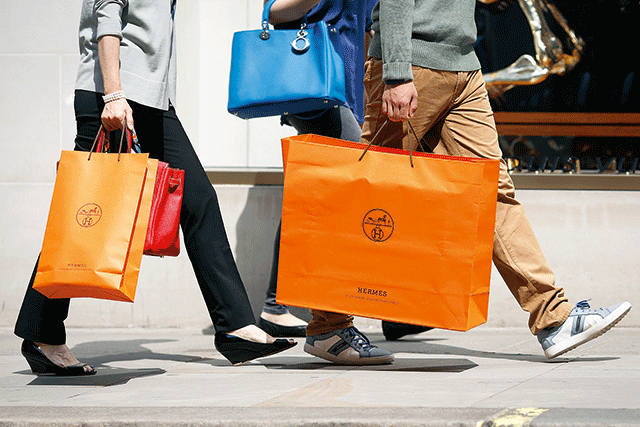It does not matter a whit if you cannot afford a Bentley or a Balenciaga wardrobe; you can still own some of the world’s leading luxury brands. There is considerable cachet in designer goods, but there are also great cash returns associated with the companies behind them.
A growing number of funds are investing in the concept of luxury, and the underlying facts make it worth mulling over.
Yes, Warren Buffett did sagely advise not to invest in a business you can’t understand, but this should not stop you from investing in certain parts of it. Apparently, luxury never goes out of demand, and it is more profitable than you may think.
If you believe this mandate is driven by the super-rich, you are wrong. During the recession, when Europeans and Americans were practising austerity and restraint, Asian middle-class consumers — especially from India and China — were buying haute couture and designer-branded goods in copious amounts. Unsurprisingly, sales and share prices of multi-brand luxury giants such as the LVMH Group, Kering and Compagnie Financière Richemont remained upbeat.
This burgeoning Asian middle class, and its buying power and prowess, form the foundation for luxury funds to flourish.
Big on spend
Juan Mendoza, Head of Equities Asia at Credit Suisse and Manager of its Global Prestige Fund and Luxury Goods Fund, says Chinese consumers with an annual income of more than $30,000 (Dh110,190) spend approximately eight times more on luxury goods than Europeans. Speaking in a video uploaded to YouTube in September 2013, he adds that Asia’s middle class will touch 1.7 billion by 2020, surpassing the combined middle classes of Europe and North America.
Rob Walker, Contributing Analyst at Euromonitor International, emphasises that Chinese tourists have been driving global luxury goods sales for more than a decade. “Last year, the Chinese made two million trips to the US and 1.7 million trips to France, and many included shopping excursions to prestigious luxury retailers. It is estimated that Chinese tourists spent around $45 billion on luxury goods,” he says in an opinion piece shared with GN Focus.
However, in Euromonitor’s Luxury Growth Ranking report for 2015-16, it is India that is predicted to experience the highest global growth in luxury goods at an annual rate of 13.4 per cent. China is fourth after Indonesia and Malaysia at 7.9 per cent, followed by the UAE with 7.2 per cent. “Rising prosperity in tier-1 cities, coupled with a big shift from the black market to the formal retail market, has turned India into one of the world’s most attractive markets for new luxury goods investment,” explains Walker.
Exposure to emerging markets
Fund managers have long seen the potential and possibilities of Asia’s emerging markets, and this is the principle at play when it comes to luxury. According to fund manager Pictet, emerging market consumers are now responsible for around 40 per cent of luxury goods sales, and everyone wants a piece of that pie.
“We remain exposed to emerging markets, which we view as a major growth engine in the coming quarters,” the firm stated in December. “Premium brand companies remain extremely strong fundamentally and well prepared to grow profitably in the near future.” Pictet’s largest holding is in the Swatch Group, which owns Breguet and a stake in the UAE-based Rivoli Group.
Besides dedicated luxury funds such as Pictet’s Premium Brands, Dominion’s Chic, Julius Baer Multistock Luxury Brands and Amundi Funds Equity Global Luxury and Lifestyle, there are also similar funds such as JPMorgan’s Global Consumer Trends. They are all targeting success based on Asian spending power.
Amundi says it “aims to benefit from an investment universe that is rich in opportunities, whether in luxury or prestige goods and services”, while Julius Baer’s open-end investment fund aims to “achieve long-term capital growth by investing in companies that own established brands and offer products and services in the luxury goods sector”. KBC Equity Fund Luxury and Tourism says the demand for luxury goods is growing three times faster than the world economy: “Not only is the sector virtually untouched by the European crisis but it also benefits from rising prosperity in emerging markets.”
The premise of a luxury fund is to invest in companies with higher revenue growth and profitability than the market norm. Although most funds do not offer performance or capital guarantees, investors are willing to flout risks for fabulous returns — most report a positive performance against global indices. R. Scott Arnell, founding partner of advisory firm Geneva Capital SA, highlights rewards and risks associated with the buying power of emerging markets in a February article on Valuewalk.com
“As per capita income rises in the Brics [Brazil, Russia, India, China, South Africa] and Mint [Mexico, Indonesia, Nigeria, Turkey] countries, the increase in demand for luxury goods and services can prove extremely lucrative… if you are an investor that might jump ship at any sign of a loss or downtick, be wary of selling off your investment too soon and missing out on opportunities that present themselves on a longer timeline.”
Mendoza adds: “Luxury goods are a long-term investment theme with above-average potential, and are less dependent on the short-term whims of markets. [These] companies enjoy high-price settings and correspondingly high margins.”
The global luxury market is set to grow exponentially. According to Bain and Company’s January report, Lens on the Worldwide Luxury Consumer, ten million consumers enter the luxury market annually, creating an estimated 400 million luxury consumers worldwide by 2020.
Leading luxury funds are available in the UAE under the Zurich, Old Mutual (previously Royal Skandia) and Fidelity platforms, which are represented by leading local banks.













